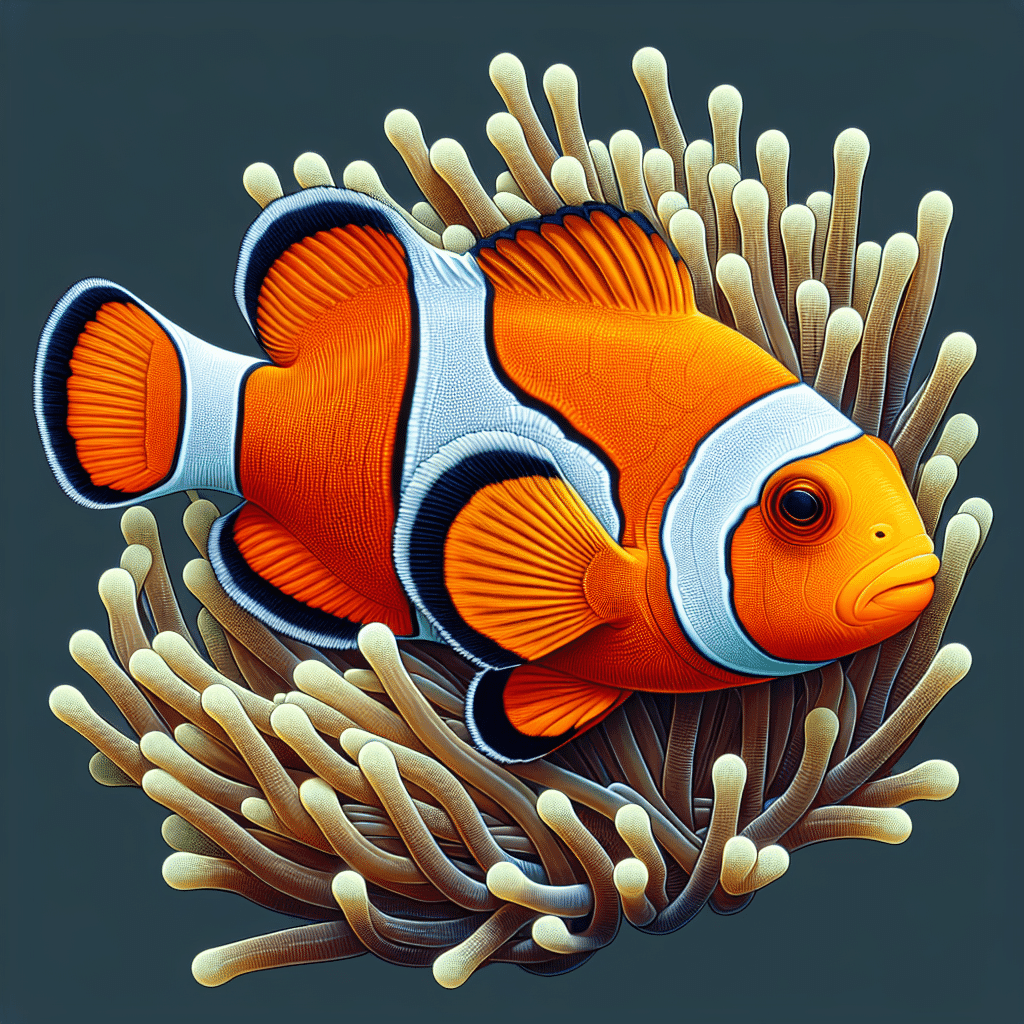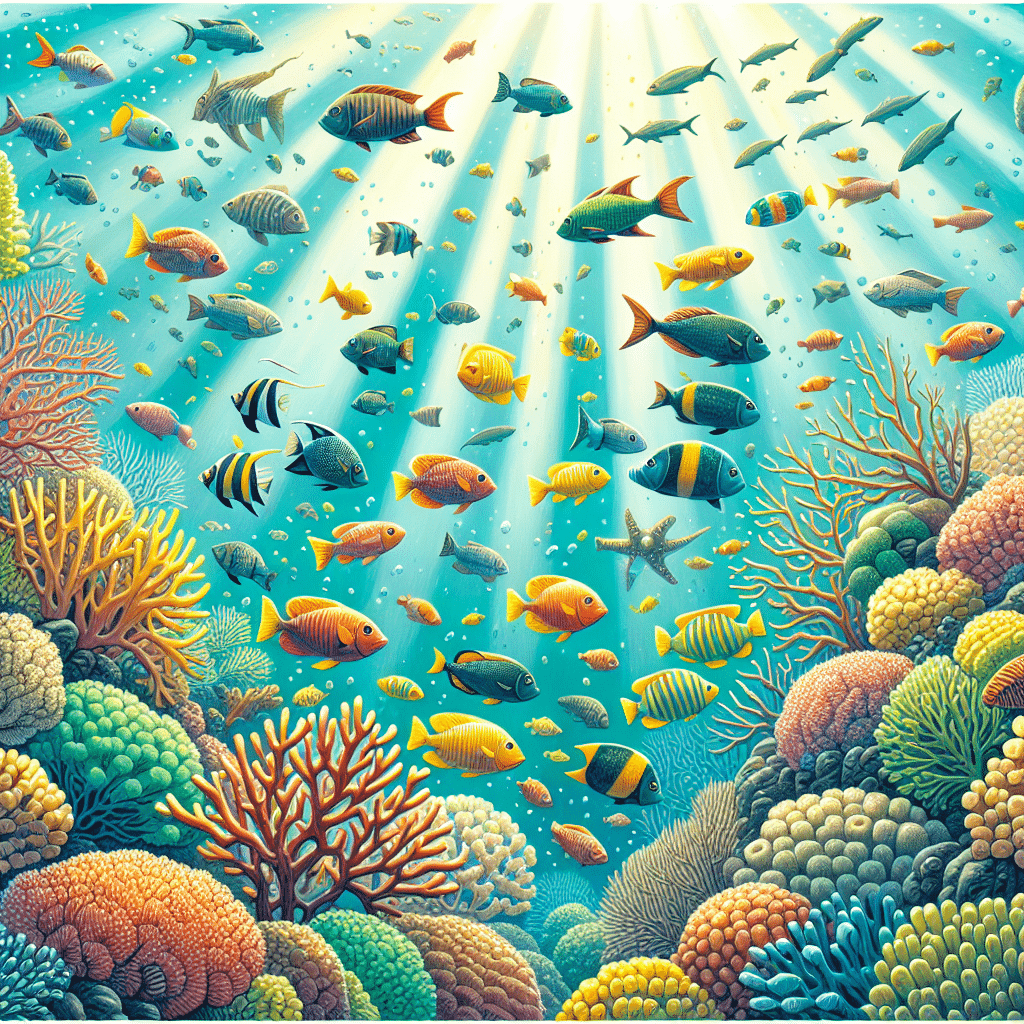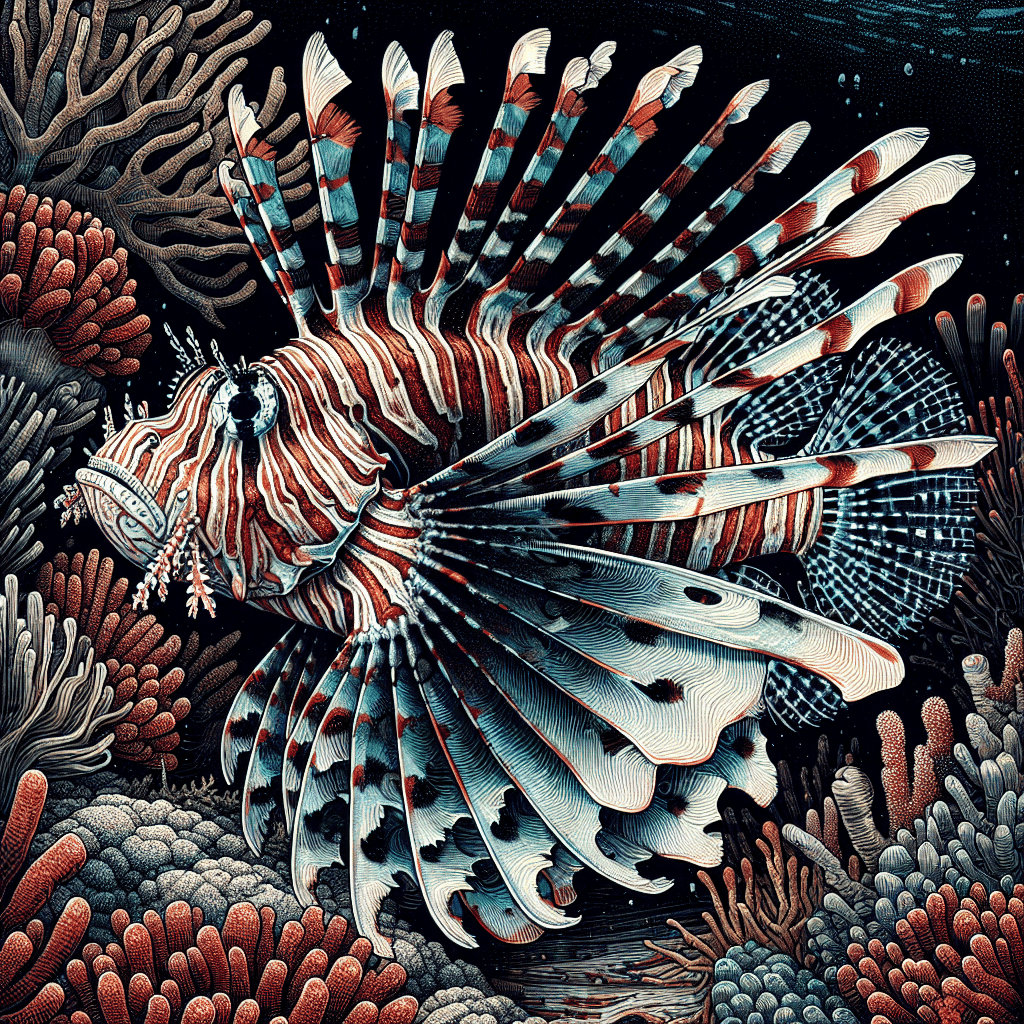Introduction to Ocellaris Clownfish
Basic Information on Ocellaris Clownfish
I find the ocellaris clownfish (Amphiprion ocellaris) to be one of the most captivating fish in the marine world. These little guys can grow up to about 11 cm (4.3 inches) long, with females generally being larger than males (Wikipedia). What really stands out is their vibrant colors; they can be yellow, orange, red, or black, often adorned with striking white details.
Ocellaris clownfish typically inhabit small groups on outer reef slopes or in sheltered lagoons, usually at a maximum depth of 15 meters. They thrive in shallow reef areas, forming symbiotic relationships with specific species of sea anemones, such as Heteractis magnifica and Stichodactyla gigantea (FantaSEA Aquariums). This mutual relationship is fascinating; the clownfish receive protection from the anemones’ stinging tentacles, while the clownfish provide nutrients through their waste.
Here’s a quick overview of some key information about the ocellaris clownfish:
| Feature | Details |
|---|---|
| Scientific Name | Amphiprion ocellaris |
| Maximum Size | Up to 11 cm (4.3 inches) |
| Habitat | Outer reef slopes, sheltered lagoons |
| Depth Range | Up to 15 meters |
| Color Variations | Yellow, orange, red, black with white details |
| Symbiotic Partners | Heteractis magnifica, Stichodactyla gigantea, Stichodactyla mertensii |
These clownfish can be found in the Indian Ocean, including the Red Sea, as well as the Pacific and the Australian Great Barrier Reef. Their ability to adapt to various marine environments makes them a popular choice among aquarium enthusiasts. If you’re interested in learning about other marine fish, check out our section on marine fish.
Ocellaris Clownfish in the Wild
Natural Habitat of Ocellaris Clownfish
The ocellaris clownfish, scientifically known as Amphiprion ocellaris, typically thrives in warm waters like the Red Sea and Pacific Oceans. These vibrant fish prefer living in small groups on outer reef slopes or in sheltered lagoons, usually at a depth of no more than 15 meters. They have a fascinating symbiotic relationship with specific species of sea anemones, including Heteractis magnifica, Stichodactyla gigantea, and Stichodactyla mertensii (Wikipedia).
These anemones provide not only protection but also a source of food for the clownfish, as they catch food debris and stinging unwanted visitors. In return, the clownfish’s waste offers nutrients to the anemone, creating a mutually beneficial relationship.
| Habitat Type | Description |
|---|---|
| Reef Slopes | Outer reef areas with good water flow |
| Sheltered Lagoons | Calm waters that provide safety |
| Depth | Typically found up to 15 meters deep |
Behavior and Social Structure
When it comes to social behavior, ocellaris clownfish are quite fascinating. They live in groups that consist of one dominant female, a dominant male, and several smaller males. The dominant male can transform into a female if the female were to die, ensuring that the social structure remains intact (Great Barrier Reef Foundation).
Communication is key in their social interactions; clownfish produce popping and clicking sounds to express themselves. This social structure not only helps maintain order within the group but also ensures effective breeding and protection against predators.
| Social Role | Description |
|---|---|
| Dominant Female | The largest female, main breeding individual |
| Dominant Male | The largest male, can turn female if needed |
| Smaller Males | Subordinate males that may become dominant |
Understanding these aspects of the ocellaris clownfish’s habitat and behavior is essential for anyone interested in keeping them in their aquariums. For more tips on keeping these beautiful fish, check out our articles on marine fish and clownfish.
Care and Tank Requirements
Taking care of my Ocellaris clownfish requires a bit of preparation and attention to detail regarding their tank setup and water conditions. Here’s what I’ve learned about creating the perfect environment for these playful little fish.
Tank Size and Setup
For my Ocellaris clownfish, a tank size of at least 20 gallons is recommended. Some sources even suggest I could use a smaller setup, but I prefer having a bit more space. Larger clownfish species, like maroon clownfish, need a bigger tank of 50 gallons or more, especially if I plan to keep a pair.
When setting up the tank, I make sure to include:
- Live Rock: This provides hiding places and surfaces for beneficial bacteria.
- Anemones: While not strictly necessary, hosting an anemone can create a beautiful and natural environment for my clownfish.
- Substrate: A sandy substrate mimics their natural habitat.
| Tank Size | Ideal for Clownfish Species |
|---|---|
| 10 gallons | Small Ocellaris clownfish only |
| 20 gallons | Ocellaris clownfish or small groups |
| 50 gallons | Larger species like maroon clownfish |
Water Parameters and Maintenance
Maintaining proper water parameters is key to keeping my clownfish healthy. Here are the specific requirements I need to keep in mind:
- Temperature: A range of 75-82°F is ideal.
- Salinity: I aim for a salinity level between 1.020-1.025.
- pH Level: The pH should be kept between 8.0-8.4.
To keep the water conditions stable, I perform regular checks and maintenance, including:
- Weekly Water Changes: I typically do a 10-15% water change weekly to ensure water quality remains high.
- Filtration: A quality filtration system helps maintain clear water and removes toxins.
- Testing Kits: I use testing kits to monitor temperature, salinity, and pH levels regularly.
With the right tank size and water parameters, my Ocellaris clownfish thrive. Whether I’m just starting out or already have a vibrant reef tank, these guidelines help ensure my clownfish are happy and healthy. For more information on other species, check out our pages on marine fish and clownfish.
Feeding Ocellaris Clownfish
Feeding my ocellaris clownfish is one of the most enjoyable parts of being a reef tank hobbyist. These little guys are not picky eaters, which makes it easy to provide them with a varied and nutritious diet.
Natural Diet of Ocellaris Clownfish
In the wild, ocellaris clownfish are omnivores. They mainly feast on zooplankton, copepods, larvae, fish eggs, small shrimp, and algae in their native Indian Ocean habitats, where they maintain symbiotic relationships with sea anemones.
In my aquarium, I aim to replicate this natural diet as closely as possible. I offer them high-quality marine pellets or flakes, frozen foods like mysis, cyclops, brine shrimp, and krill. They also enjoy live food and vitamin-soaked freeze-dried options. Seaweed sheets (nori) and algae tabs are great additions as well.
| Food Type | Description |
|---|---|
| Marine Pellets/Flakes | High-quality, balanced nutrition |
| Frozen Foods | Mysis, brine shrimp, cyclops, and krill |
| Live Food | Provides natural hunting behavior |
| Seaweed Sheets | Rich in vitamins and minerals |
| Algae Tabs | Supports digestive health |
Feeding Schedule and Tips
For my clownfish, I typically feed them once a day. However, if I have breeding or juvenile fish, I increase the feeding frequency. It’s essential to avoid overfeeding, as this can lead to water quality issues in the tank. A good rule of thumb is the “eyeball method,” where I feed about as much as the size of the fish’s eye each day.
When it comes to young clownfish, baby larvae are initially fed rotifers and then very fine fry foods. As they grow, I transition them to crushed pellets or flakes. Feeding fry can be challenging due to their small size, so I set up a culture of tiny critters to provide a consistent food source before the eggs hatch.
It’s fascinating to watch them grow, especially knowing that clownfish eggs hatch in about 6 to 8 days, depending on water temperature and species. Observing the eggs turning silver with visible larvae inside helps me predict when they’ll hatch.
By providing a varied and balanced diet, I ensure my ocellaris clownfish remain healthy and vibrant. For more information on different types of fish you can keep, check out our articles on marine fish and other fascinating species.
Breeding Ocellaris Clownfish
Breeding Ocellaris clownfish can be an exciting and rewarding experience. As I delve into their reproductive behavior and the process of rearing their fry, I’m often amazed by how fascinating these little fish can be.
Reproductive Behavior
Ocellaris clownfish, also known scientifically as Amphiprion ocellaris, exhibit a monogamous mating system. This means each pair forms a lasting bond. The breeding pair establishes a hierarchy based on age and sex, which is essential for their social structure. Males often become more aggressive during the spawning process, ensuring their territory is protected. Interestingly, the male clownfish takes on a significant role in caring for the eggs, which includes eating any fungi-infected or infertile eggs, as well as fanning the eggs to ensure they receive adequate oxygen.
Clownfish can spawn at any time throughout the year. Once the female lays her eggs, the male diligently guards them until they hatch. It’s fascinating to note that all clownfish start life as males; once they transition to female, they cannot revert back.
Rearing Clownfish Fry
After the eggs are laid, they typically hatch in about 6 to 8 days, although this can vary based on factors like water temperature and species. Observing the eggs as they turn silver with visible clownfish larvae is an exciting way to predict hatching time (Ocellaris Clownfish).
Once the fry have hatched, they enter a delicate stage of development. Clownfish larvae metamorphose into actual fish around day 10 of their lives. During this critical period, it’s essential to ensure their survival, as they may not survive the first attempt. If they do not, the clownfish pair usually spawns again soon after (FantaSEA Aquariums).
In terms of nourishment, clownfish larvae require a specific diet. For the first few days of their lives, they must be fed rotifers, as they will not accept dry food during this initial stage. Rotifers are vital for their survival and growth. Keeping their environment stable and providing the right food can significantly enhance their chances of thriving in captivity.
By understanding the reproductive behaviors and care requirements of clownfish, I’ve found that breeding these charming fish becomes a fulfilling endeavor. If you’re venturing into breeding, be prepared for a delightful journey into the world of clownfish!
Threats and Conservation
Challenges Faced by Ocellaris Clownfish
Ocellaris clownfish, known for their vibrant colors and charming personalities, face several challenges in the wild. One of the most pressing issues is over-collection for the marine ornamental trade. A staggering 75% of clownfish are captured from their natural habitats to meet the high demand in aquariums (Great Barrier Reef Foundation). This over-exploitation can significantly reduce local populations, making them more vulnerable to other threats.
Another critical challenge is habitat degradation. The coral reefs that serve as essential homes for these fish are suffering from various issues, including pollution, coastal development, and the impacts of global climate change. As these reefs decline, so does the health and survival of the clownfish that rely on them for shelter and breeding.
Even though the Ocellaris clownfish is not currently classified as threatened or endangered, the combination of over-collection and habitat loss raises concerns about their long-term viability (Animal Diversity Web).
Conservation Efforts
To combat these challenges, various conservation efforts are underway. One of the most effective strategies has been the promotion of captive breeding programs. These initiatives reduce the pressure on wild populations by providing a sustainable source of clownfish for the aquarium trade. Recent advancements in breeding techniques have led to a surge in the availability of captive-bred clownfish, which are often healthier and more resilient than their wild-caught counterparts.
Additionally, raising awareness about responsible aquarium practices is crucial. Educating hobbyists on the importance of selecting captive-bred fish and avoiding the purchase of wild-caught specimens helps protect the delicate balance of clownfish populations in their natural habitats. Implementing and adhering to sustainable practices in the aquarium trade is vital for ensuring the survival of these beautiful fish.
Efforts to protect coral reef ecosystems also play a significant role in the conservation of Ocellaris clownfish. Organizations are working on initiatives to restore degraded reefs, reduce pollution, and combat climate change, all of which are essential for maintaining healthy habitats for clownfish and many other marine species.
By supporting these conservation efforts, we can help ensure that future generations can enjoy the beauty and charm of Ocellaris clownfish in both the wild and our aquariums. For more information on marine fish, check out our other articles on marine fish and specific species like the clownfish.
Captive Breeding and Aquarium Trade
Captive breeding has become a popular topic among fish tank and reef tank hobbyists, especially for those interested in species like the ocellaris clownfish. Understanding the benefits of this practice, as well as its impact on the aquarium trade, can help me make informed decisions for my own aquarium setup.
Benefits of Captive Breeding
One major advantage of captive breeding is the reduction of pressure on wild populations. With more enthusiasts raising their own clownfish, fewer fish need to be harvested from the ocean. This practice not only helps sustain wild populations but also promotes healthier fish for aquarists. Captive-bred clownfish tend to be hardier and adapt better to life in aquariums than their wild counterparts.
Moreover, breeding clownfish in captivity can provide a unique experience. For those who are passionate about fishkeeping, raising clownfish fry can be a rewarding project. Clownfish breeding is manageable with some dedication, making it a fun venture for experienced aquarists. The first few days are critical, as clownfish larvae require a specialized diet of rotifers, which are essential for their survival.
| Benefit | Description |
|---|---|
| Sustainable Practices | Reduces pressure on wild clownfish populations. |
| Healthier Fish | Captive-bred clownfish adapt better to aquarium life. |
| Educational Experience | Breeding offers a hands-on learning experience for enthusiasts. |
Impact of the Aquarium Trade
The aquarium trade has seen significant changes due to the rise in captive breeding. The demand for wild-caught clownfish has decreased as hobbyists become more aware of the benefits of captive-bred specimens. This shift has encouraged many breeders to enter the market, resulting in a wider variety of clownfish available for aquarists.
While the aquarium trade offers a plethora of options, it’s essential to ensure that the sources are sustainable. Ethical practices in breeding and selling fish have become increasingly important. By supporting responsible breeders, I can contribute to the conservation of marine life while still enjoying the beauty of an ocellaris clownfish.
Additionally, the aquarium trade has facilitated the creation of specialized products for clownfish care, including suitable habitats and diet options. This ensures that both novice and experienced fishkeepers have access to the resources needed to maintain healthy aquarium environments.
In summary, the benefits of captive breeding and its positive impact on the aquarium trade highlight the importance of making informed choices as a hobbyist. Embracing these practices can enhance my fishkeeping experience while contributing to the sustainability of marine ecosystems.
Fun Facts and Trivia
Interesting Tidbits about Ocellaris Clownfish
I find Ocellaris clownfish to be fascinating little creatures. They are social fish that communicate using popping and clicking noises. Living in groups, they have a unique social structure with one dominant female, a dominant male, and a few smaller males. If the dominant female dies, the dominant male can transform into a female, and the largest of the smaller males takes over as the new dominant male (Great Barrier Reef Foundation).
Another cool fact is their symbiotic relationship with sea anemones. The anemone provides protection from predators and offers food scraps, while the clownfish lures fish into the anemone, fertilizes it with its waste, and helps ensure its survival. It’s a win-win situation!
Unique Characteristics
Ocellaris clownfish are born as males and, once they become female, they cannot revert back to male. After laying eggs, the male guards them until they hatch, which adds another layer to their parenting behavior. Interestingly, clownfish larvae go through a metamorphosis into actual fish around day 10 of their lives, which is a critical stage for survival. If they don’t make it the first time, the pair usually spawn again soon after (FantaSEA Aquariums).
However, it’s worth noting that clownfish populations have faced challenges due to the marine ornamental trade, with around 75% of them being captured from the wild. Protecting these vibrant fish is essential, not only for their survival but also for maintaining the delicate balance of their ecosystems.
With their striking colors and engaging behaviors, Ocellaris clownfish can add a lively touch to any reef tank. If you’re looking to learn more about other marine species, check out our articles on marine fish, clownfish, and other fascinating reef dwellers like seahorses and triggerfish.



